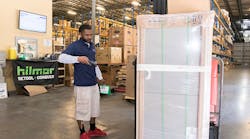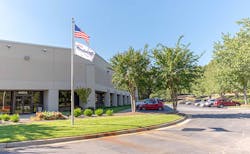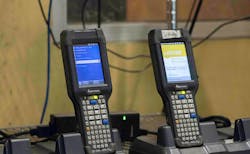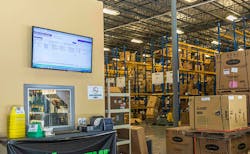Mingledorff’s is a name synonymous with high-quality HVAC equipment and expert customer support. Today the company stocks a growing range of products from hundreds of heating and air conditioning equipment manufacturers such as Carrier, Bryant, Mitsubishi, and more. Since its founding in 1939, this family-owned business has grown into a regional powerhouse, serving customers from 35 locations stretching across Alabama, Florida, Georgia, Mississippi, and South Carolina.
These 35 stores are separated into five districts, each with a central hub to help efficiently manage the movement of inventory. Three of these hubs are located in Georgia, including the company’s headquarters in Norcross, while the other two hubs are in Alabama’s Birmingham and Loxley areas.
Like other HVAC suppliers, Mingledorff’s inventory consists of an enormous variety of products ranging in size from tiny screws and bolts up to large air-conditioning equipment and related components.
“Some of our stock can be stored in a box. Some requires a forklift to be moved,” said Sean Wallace, head of Mingledorff’s Business Systems Group, which incorporates the company’s ERP, warehousing, application support and training. “Because each of our locations also functions as a retail store-front, the space requirements and the level of variability can be difficult to manage.”
“But the most challenging part of our process from a distribution perspective was the lack of traceability,” Wallace continued. “We used to handle receiving with a pen and a piece of paper. Understandably, when this system failed, we had very few ways of verifying what had happened. Our paper trail took too much time to dig through, and it was often unreliable. We realized that we needed sustainable data to track everything about our inventory from the point of receiving on the dock all the way to that item being available for sale. We needed new technology that would improve operational efficiency.”
TUG Connects 2016
Being an Infor SX.e user, Mingledorff’s searched for a Warehouse Management System (WMS) that would integrate seamlessly with its existing ERP software. The company attended TUG Connects in San Antonio in 2016 and spoke with PathGuide Technologies, maker of Latitude WMS. It didn’t take long for Mingledorff’s to decide to move ahead with a phased Latitude WMS rollout that would handle cycle counting, receiving and putaway. This meant abolishing pen and paper for good.
WMS Deployment
Mingledorff’s embarked on an aggressive WMS deployment plan that included each of its 35 locations. The process started at its Marietta location in Georgia, which boasts some of the company’s highest foot traffic and transaction volumes. Marietta was also an ideal pilot location due to its proximity to the support team in Norcross.
“After our initial rollout of Latitude in Marietta, we decided that the only way to effectively deploy Latitude was to multiply our efforts,” said Wallace. “We did this by handing off responsibility to the operations manager in each district and by reallocating a couple of the staff at each location to be trainers and Latitude WMS champions. In practice, this meant that we taught the operations manager in Birmingham how to use the system and implement it across that site. From there we moved to our hub in Loxley, Alabama, where we trained that center’s operations manager. Finally, our team went to Mingledorff’s hubs in Macon and Savannah, Georgia to complete the same rollout. We couldn’t have achieved it without everyone’s buy-in from the top down. It was a real whirlwind with five or six sites actively deploying at any one time.”
Like many companies adopting a new WMS, Mingledorff’s switched Latitude on in stages, starting with a full month of receiving. Mingledorff’s used what it learned in Marietta to make the rollout much faster in subsequent locations. Each new branch would start by reassigning the primary bins of every product in the warehouse. By the next day, these branches were able to start receiving with Latitude. After another two days, the branch would turn on shipping. And then after the initial full week, the warehouse was primed to conduct its first physical inventory. A team would actively supervise each site for an additional week, during which time the warehouse team would be fully operational, conducting all receiving, picking, shipping and cycle counting using Latitude.
“We started the implementation at our Marietta location in March 2017, and by Thanksgiving our team had Latitude up and running at every one of our 35 locations,” added Wallace.
Easy Learning Curve
Having so many branches come online at the same time wasn’t an easy task, but once Mingledorff’s overcame its initial customization hurdles, things quickly smoothed out. The deployment was so fast that Mingledorff’s planned from the beginning to conduct additional training sessions with employees in 2018, just to make sure they hadn’t fallen back into old habits.
“Our new handheld RF computers are great, but introducing new processes meant that we had to unlearn some bad habits,” continued Wallace. “For new employees, this can be an advantage. We’ve seen some new warehouse employees become the top picker at their branch within a month. A big part of that can be attributed to the automated picking process. Employees used to spend an awful lot of time trying to figure out what to pull, but now they’re being directed to the location by the handheld terminal, so it takes much less time to get up to speed. We also purchased large monitors and Chromebooks for each warehouse, motivating everyone to stay on top of our open sales orders.”
On the back end, the WMS interface being used by Mingledorff’s was developed with PathGuide to have a very small footprint on the SX.e software. With this in place, Latitude only needs to write to a single table in the ERP, while other operations rely on standard Infor processing. That simple integration was important for Mingledorff’s because it allowed the company to call upon Infor’s support and expertise at any time.
Knowledge is Power
For Mingledorff’s, the introduction of a WMS has made warehouse operations faster, more streamlined and less error-prone.
“Having Latitude has helped us improve accuracy on the receiving end while giving us quantifiable data that help pinpoint errors instantly,” Wallace concluded. “I’m excited that our team now has more time to spend improving customer service and safety. We anticipate the summer period to be our busiest ever, but we’ll be able to dramatically reduce the number of seasonal employees. And anyone who is hired will have a much easier time getting up to speed. That room to grow is critical to our ongoing success.”













